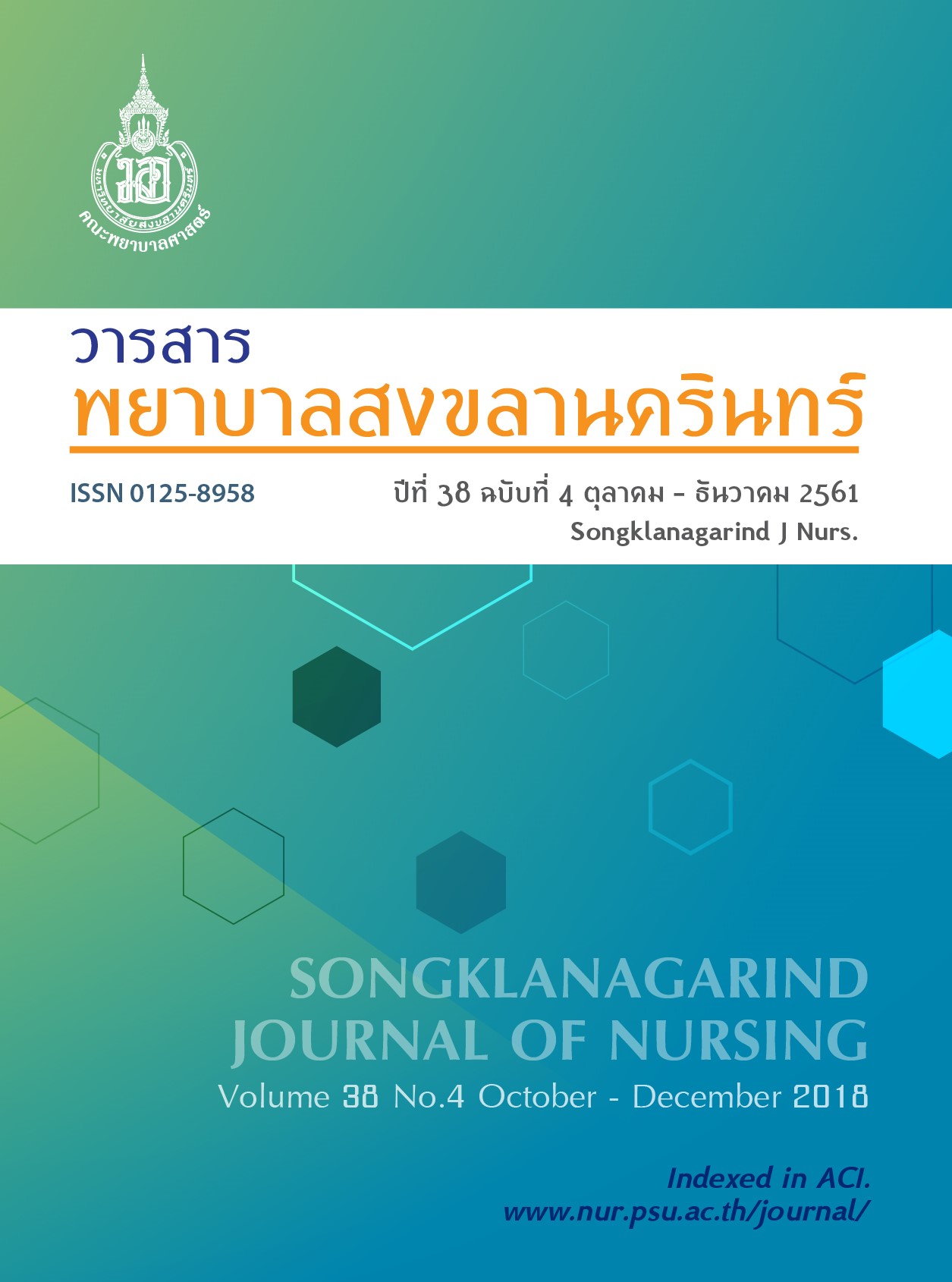Child Caring Behaviors Regarding Preventive and Control for Communicable Diseases at Home of Guardians and at the Early Childhood Development Division of Caregivers
Main Article Content
Abstract
This descriptive research aimed to study the level of child caring behaviors and comparison of child caring behaviors regarding preventive and control for communicable diseases at home of guardians and at the early childhood development division of caregivers. Purposive sampling was used to selected 108 guardians who brought their children to early childhood development division and 18 caregivers at the early childhood development division. The data were collected using self-reported questionnaires consisted of 1) demographic data, 2) child caring behaviors regarding preventive and control for communicable diseases at home of guardians, and 3) child caring behaviors regarding preventive and control for communicable diseases at the early childhood development division of caregivers. The questionnaires were tested for face validity and for the reliability of questionnaires 2-3, yielding Cronbach’s alpha coefficients of .81 and .78, respectively.
The data were analyzed using descriptive statistics and independent t-test.
The results revealed that the mean scores of the child caring behaviors of guardians and caregivers were at a high level both overall (M ± SD = 3.88 ± 0.48 vs. 4.63 ± 0.26) and dimensions such as caring of child personal hygiene (M ± SD = 3.93 ± 0.49 vs. 4.65 ± 0.28), caring of guardians or caregivers’ personal hygiene (M ± SD = 3.69 ± 0.83 vs. 4.65 ± 0.42), caring child with communicable diseases (M ± SD = 3.69 ± 0.67 vs. 4.69 ± 0.35), and appliance and environmental care (M ± SD = 4.21 ± 0.57 vs. 4.53 ± 0.26). Independent t-test analysis showed that the overall and all dimension mean scores of child caring behaviors of caregivers were significantly higher than those of the guardians (p< .001). Thus, to prevent communicable diseases, the heads of early childhood development division should promote child care behaviors of the guardians and continuously maintain these behaviors for caregivers.
Article Details
References
2. Pensuk P, Banchonhattakit P. Effects of behavioral modification for hand foot mouth disease prevention among parents of pre-school children in child development center, Ban Kruat District, Burirum Province. The Public Health Journal of Burapha University. Public Health J Burapha Univ. 2013; 8(1): 80-93. Thai.
3. Early Childhood Development Division, Faculty of Nursing, Prince of Songkla University. Record of illness incidence of children 2014-2016. Songkhla: Faculty of Nursing, Prince of Songkla University; 2017. Thai.
4. Sen-Ngam K, Jamjan Kulvijit J, Kongsang L. Health status and factors related to health status of children attending at the early childhood development center. Songklanagarind Nurs J. 2012; 32(1): 11-26. Thai.
5. Bhudhisawasdi1 K, Leelasethe T, Teeratakulpisarn J. Natural history of the common cold with respect to day-care attendance at a University Hospital in Khon Kaen, Thailand. SrinagarindMed J. 2009; 24(3): 260-4. Thai.
6. Bureau of General Communicable Diseases, Department of Disease Control, Ministry of Public Health. Guideline of prevention and control communicable diseases in day care centers (for caregivers). 2 nd ed. Bangkok: National Office of Buddhism Press. Thai.
7. Kaewsuk C, Pongjaturawit Y, Chaimongkol N. Factors associated with maternal behavior in prevention of acute respiratory infection in preschool children. The Journal of Faculty of Nursing Burapha University. 2016; 24(4): 54-64. Thai.
8. Boonrung J. Prevention of upper respiratory tract infection situation in pre-school children at early childhood developmental center of Kaopanom Subdistrict Municipality Krabi Province [master ‘s minor thesis]. [Nakhon Si Thammarat]: Walailak University; 2012. 87 p. Thai.
9. Pimprasert S. The influencing factors on preventive behavior regarding hand, foot, mouth disease of mothers: case study at day care center, Prachasuksan sub-district, Lan Krabue District, Kampaengphet province. [master thesis]. [Phitsanulok]: Naresuan University; 2009. 61 p. Thai.
10. Chanakun U. Behavior of teachers for control and prevention of hand foot mouth disease in childcare centers Mueang District, Krabi Province. CHD-KKU. 2015; 3(3): 453-468. Thai.
11. Udomsaree N, Kanokthet T. Factors association to preventive behaviors hand, foot and mouth disease among parent children in the child development center, Chumtabong Sub-district, Chumtabong District, Nakhon Sawan Province. Paper presented at: The 4th National Conference at Rajabhat Phetchabun University. Proceeding of The 4th National Conference at Rajabhat Phetchabun University; 2017 Mar 10; Phetchabun. Thai.
12. Chokechalearmwong C. The factors influencing preventive health behaviors amongst parents of children aged 3-5 with recurrent acute diarrhea [master thesis]. [Bangkok]: Christian University of Thailand; 2012. 115 p. Thai.
13. Issarasongkhram M, Boonprakong T, Chunkao K. Knowledge and practices in control and prevention of communicable diseases of childcare volunteers in early childhood development centers, Bangkok. BCN, Bangkok. 2015; 31(2): 80-91. Thai.
14. Sangkhaw A. Child care behaviors of attendants in the child care centers [master thesis]. [Nakhon Pathom]: Silpakorn University; 2007. 129 p. Thai.
15. Jaide C, Santati S, Kongsaktrakul C. Factors related to child care workers’ behavior in prevention of acute respiratory infection in child care centers. Rama Nurs J. 2012; 18(3): 389-403. Thai.
16. Weiangkham D, Ponmark J, Thisara P, et al. Predictors of preventive behaviors for hand foot mouth disease among caregivers in childcare centers. J Nurs Health Care. 2017; 35(2): 16-24. Thai.
17. Sangnimitchaikul W, Rutchanagul P. Factors predicting preventive health behavior regarding hand, foot, and mouth disease among prekindergarten’s caretakers and parents. Rama Nurs J. 2015; 21(3): 336-351. Thai.
18. Bodeerat P, Kanokthet T. Factor affecting health-protective behavior of hand, foot and mouth disease among parent and babysitters of pre-school children at day-care center in Lankrabue District, Kamphaengphet Province. Paper presented at: The 6th Academic Meeting National and International Conference at Suan Sunandha Rajabhat University. Proceeding of The 6th National Conference at Suan Sunandha Rajabhat University; 2015; 1(6): 347-356; Bangkok. Retrieved from http://journalgrad.ssru.ac.th/index.php/5-01/article/view/135 Thai.
19. Wongratana, C. Use of statistic technique for” research. 11 th ed. Bangkok: Thepneramit Press; 2009. Thai.
20. Bureau of Health Promotion, Anamai Department, Ministry of Public Health. Standard guide for quality of childcare centers. Nonthaburi: Bureau of Health Promotion, Anamai Department; 2015. Thai.

